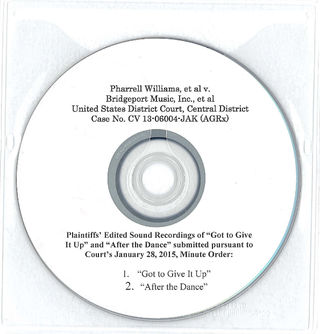
Robin Thicke and Pharrell Williams are headed to court next week to refute claims that their 2013 tune “Blurred Lines” infringed on Marvin Gaye’s hit “Got To Give It Up.”
If you believe the doom and gloom of the Gaye estate’s lawyers, the case is controversial because it could rewrite the rulebook on what copyright infringement means for musicians. The judge has decided to allow a jury to hear only the copyrighted elements of Gaye’s 1977 hit song — a bizarre twist — and the Gaye lawyers fear that his decision will expose historic music to widespread copying.
But just what are the ‘copyrighted elements’? Answering that question is a bizarre opportunity to look at pop culture through the eyes of the law, brushing aside things like, you know, percussion.
When you listen to the two songs, there’s no question: they kind of sound alike — the upfrontness of the stepwise bass lines, the falsetto lead vocal, the percussion style, the party in the background. But none of these elements are found in the sheet music, which is what Marvin Gaye’s people registered with the Copyright Office.
Since “Got To Give It Up” was released in 1977 — just before the last major copyright reform went into effect in 1978 — the jury has to look to the 1909 copyright law to see what elements of the song are covered by copyright.
In a pre-trial motion last October, the judge went so far as to say the jury shouldn’t be allowed to listen to the Marvin Gaye song at all, because they’d be too likely to hear the things that are not covered by copyright and conflate them with the things that are.
But in the last week or so, the docket filings have been piling up and the judge has changed course on that position. The Gaye estate had already filed mash-ups of the two songs to demonstrate how similar they were. Perhaps inspired by those recordings, the judge suggested an unusual and uniquely modern twist: both sides could try submitting versions of “Got To Give It Up” that consist of only the copyrighted elements of the song. In other words, both sides should agree how to distill “Got To Give It Up” down to its basic copyrighty essence — a fire mixtape of pure copyrightium.

Both sides eventually agreed to this condition and edited together the versions of “Got To Give It Up” the jury is likely to hear. If it’s not written down in the sheet music it’s off the table, meaning that the courtroom version of “Got To Give It Up” likely sounds like the MIDI version that auto-played on a Geocities home page, or a rendition by the animatronic band at Chuck E. Cheese.
The Gaye estate agreed to this exercise only under protest, arguing that, basically, if we limit copyright protection to the things that copyright protects, it’ll lead to a free-for-all over the unprotected elements of other older recordings, like the Beatles and Elvis. In their words, “Adopting such a position would create dangerous and potentially devastating precedent to the owners of such intellectual property.”
To that, the Thicke and Williams camp says: well, yeah. Copying the uncopyrighted elements of a song is just a matter of musical influence, and it’s how the system works. See, e.g., Interpol trying their hardest to be Joy Division, Lady Gaga doing the whole Madonna thing, the now-sorta-chuckleworthy allegations that Coldplay just rips off Radiohead, etc., etc.
When we say a song “sounds like” a certain era, it’s because artists in that era were doing a lot of the same things — or, yes, copying each other. If copyright were to extend out past things like the melody to really cover the other parts that make up the “feel” of a song, there’s no way an era, or a city, or a movement could have a certain sound. Without that, we lose the next disco, the next Motown, the next batch of protest songs.
In that sense, this case has something in common with the landmark sampling cases like Grand Upright v. Warner Brothers or Bridgeport v. Dimension. Even the players are familiar: music publishing company Bridgeport was a plaintiff that played an early role in the “Blurred Lines” case, too. The outcome of these cases — a resounding “Get a license or do not sample” — had a huge effect on musical creativity, dramatically changing the sound of hip hop by rendering the sonic landscape of many interwoven samples impossible. A legal victory by the Gaye estate could have similar effect, casting doubt on the kind of musical interplay that has always been considered acceptable.
So no matter how much you might hope that Marvin Gaye would triumph in court over Robin Thicke — and you know you want it — this boils down to a case of everyday musical influence. There’s no question that Thicke and Williams were influenced by Marvin Gaye. But at the end of the day, they’re guilty of nothing worse than letting their influences show through a little too clearly.
[Ratter]
